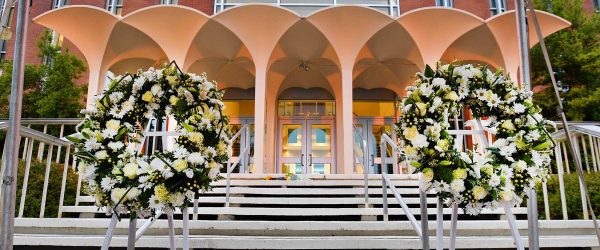University remembers April 30, 2019, through virtual program, wreath ceremony

The one-year anniversary of the shooting that took place on UNC Charlotte’s campus began with an early morning presentation of memorial wreaths placed at the threshold of the Kennedy Building, the site of the incident that claimed the lives of students Riley Howell and Ellis Reed Parlier and where four of their classmates were injured.
Led by Jeffrey Baker, chief of the University’s Department of Police and Public Safety, whose team responded first to the classroom emergency, uniformed patrol officers processing in unison delivered the wreaths, positioning them exactly where hundreds of flowers, candles, poems and letters were left on April 30, 2019, and the days following, to honor the victims of the day Chancellor Philip L. Dubois described as “the saddest in UNC Charlotte’s history.”
“April 30th will be remembered as a terribly tragic day,” said Dubois. “However, what makes this campus great is the way we deal with it. We must acknowledge it and try to take away a grain of goodness or thread of gold. For UNC Charlotte, that was in the way the campus community came together and how the city embraced its public university.”
Taking the place of the originally planned “Day of Remembrance,” which was to include on-campus memorial events and a community concert at the Blumenthal Performing Art Center, was “United: A Remembrance Program,” designed to comply with the parameters of statewide coronavirus-related, shelter-in-place guidelines.
The 30-minute program was streamed live on Thursday, April 30, 2020, starting at approximately 5:10 p.m. It was timed to conclude at approximately 5:40 p.m., the time of last spring’s tragedy.
The virtual remembrance featured comments from Dubois, Vice Chancellor of Student Affairs Kevin Bailey and Student Government Association president and vice president, Chandler Crean and Adela Mann. UNC Charlotte alumnus and CBS correspondent Don Dahler ’91, who had planned to host the original, live concert, introduced special elements of the virtual remembrance.
University alumni John Woodall ’14 and Kevin Brawley ’13, two members of the band Water from Fire, performed favorite songs of those killed, Electric Light Orchestra’s “Mr. Blue Sky” in memory of Reed, and for Riley, they performed “American Dream” by Switchfoot.
Crean introduced an original video featuring graphics by Jeffrey Murphy, associate professor in the College of Arts + Architecture, with an original arrangement by John Allemeier, professor of composition.
Mann, the SGA vice president, closed out the virtual remembrance by ringing the UNC Charlotte Victory Bell, which was gifted to founding educator Bonnie Cone in 1961 when Charlotte College moved from its former site at Central High School to its current location. The bell tolled seven times, to honor Reed and Riley; the four students injured, Drew Pescaro, Emily Houpt, Rami Alramadhan and Sean DeHart; and to recognize all students present in the Kennedy Building classroom that day.
“Today’s virtual remembrance will not be the last time we talk about April 30, 2019,” said the chancellor. “It’s part of our essential history, no matter how painful. Going forward, the memorial that will be constructed in honor of the victims will be an enduring reminder to everyone who sets forth on this campus that their lives mattered—to their families, to their friends, to Charlotte and to us.”
The Niner Nation Remembrance Commission, formed by Dubois in May 2019, recommended the creation of a significant, focal memorial and commemorative space in Belk Plaza, between the front of Kennedy and the recently completed ellipse and fountain. The concept and objectives for the memorial will be to remember Reed Parlier and Riley Howell by name; acknowledge those wounded, both physically and psychologically; invoke the unity, strength and resilience of the UNC Charlotte community; create a commemorative space that is interactive and/or occupiable; and combine landscape, architecture and art to provide a place of pause in the center of campus; and be appropriate to scale of the site and existing landscaping, hardscaping and architecture of the surrounding campus and integrate the memorial into Belk Plaza.
Read the commission’s final report.